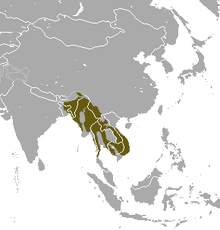Northern porcupine monkey
| Northern porcupine monkey | ||||||||||||
|---|---|---|---|---|---|---|---|---|---|---|---|---|

Northern porcupine monkey in Khao Yai National Park |
||||||||||||
| Systematics | ||||||||||||
|
||||||||||||
| Scientific name | ||||||||||||
| Macaca leonina | ||||||||||||
| ( Blyth , 1863) |
The northern porcupine monkey ( Macaca leonina ) is a species of primate from the genus of macaques within the family of the vervet monkeys (Cercopithecidae). It is closely related to the southern pig monkey ( M. nemestrina ) and was originally considered a subspecies of its relative.
distribution
The distribution area of the northern porpoise is in mainland Southeast Asia . It begins in the west in the parts of northeast India and Bangladesh located east and south of the Brahmaputra and extends across Myanmar (including the Mergui Archipelago ), Thailand, Laos, Cambodia and Vietnam to the southwest of the Chinese province of Yunnan and in the south to the Thai provinces of Surat Thani and Krabi on the Malay Peninsula . There are large gaps within the range and in Cambodia the species is only found in 5 of the 24 provinces. In the north, the distribution area of the northern porcupine partially overlaps that of the Assam macaque ( Macaca assamensis ).
features
Northern porpoises reach a head body length of 40 to 49 (females) or 50 to 59.5 (males) centimeters, the tail is very short with 16 to 20 (females) or 18 to 25 (males) centimeters. The weight varies from 4.4 to 5.7 (females) or 6.2 to 9.1 (males) kilograms. The fur is olive-brown or yellow-brown on the back and sides of the body, becomes more gray-brown towards the back and the belly is whitish. The hair on the head is short, a dark stripe in the middle of the head extends almost to between the eyes. In the males, the hair on the shoulders is 7 to 10 cm long. The fur of adult females is shorter, lighter and more greyish than that of the males. Animals not yet sexually mature are even lighter and grayish than the females. Newborns are black, but their fur turns brownish after a few months. During the period of fertility, female northern porpoises develop a conspicuous red sexual swelling that extends to the base of the tail.
habitat
Northern pig monkeys live in dense, evergreen tropical and subtropical forests up to heights of 2000 meters, in the lowlands in primary and secondary rainforests and in dry forests characterized by wing fruit trees . In Thailand and Laos it is often observed in forests that accompany river banks, in northeastern India in tea plantations and near human settlements.
Way of life
It is diurnal and lives in groups made up of several females and males with their offspring. The group size is 12 to 40 animals, the sex ratio in Assam is 1: 5.5 (males to females). The territories that a group claims are about 80 to 350 hectares. The territories of neighboring groups overlap by 25 to 48%. Large groups of 50 to 150 specimens observed are likely made up of several groups that have temporarily banded together.
In eastern Assam, animal nutrition was studied more closely. Two thirds of it consists of fruits, and leaves, seeds, stems, creepers, roots, flowers, bamboo shoots , tree sap, insects and their larvae, termite eggs and spiders are eaten. They also go to the fields and eat rice and vegetables. In Khao Yai National Park , Thailand, tourists are begged for biscuits or fruit. The females get a single young after a gestation period of 162 to 186 days. In western Thailand, most boys are born in June and December. Northern porcupines lived to be over 30 years old in captivity.
Mainly due to the destruction of their habitat, the northern porpoise is listed by the IUCN as endangered ("vulnerable").
literature
- Thomas Geissmann : Comparative Primatology. Springer-Verlag, Berlin et al. 2003, ISBN 3-540-43645-6 .
Individual evidence
- ↑ a b c d e Elizabeth L. Gadsby, Colin P. Groves, Aoife Healy, K. Praveen Karanth, Sanjay Molur, Tilo Nadler, Matthew C. Richardson, Erin P. Riley, Anthony B. Rylands, Lori K. Sheeran, Nelson Ting, Janette Wallis, Siân S. Waters & Danielle J. Whittaker: Family Cercopithecidae (Old World Monkeys). Pages 636-637 in Russell A. Mittermeier , Anthony B. Rylands & Don E. Wilson : Handbook of the Mammals of the World: Volume 3. Primates. Lynx Editions, 2013 ISBN 978-8496553897
- ↑ Macaca leonina in the Red List of Endangered Species of the IUCN 2008. Posted by: R. Boonratana u. a., 2008. Retrieved January 2, 2009.
